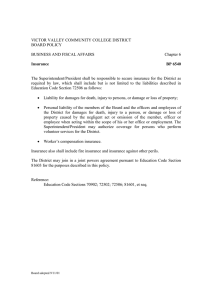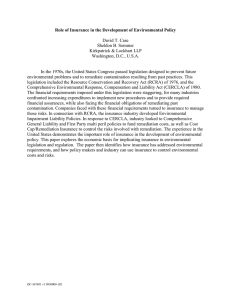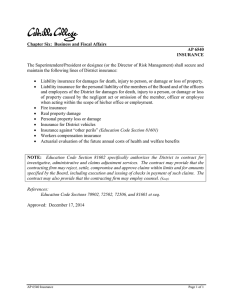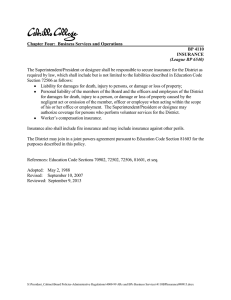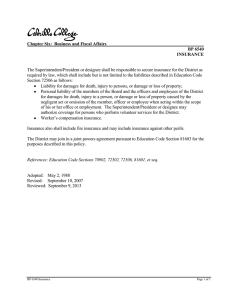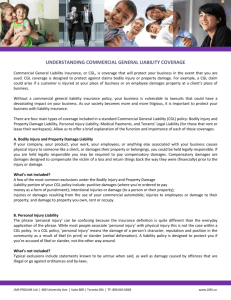Insurance Coverage Insurance Coverage for Natural Resource Damages
advertisement
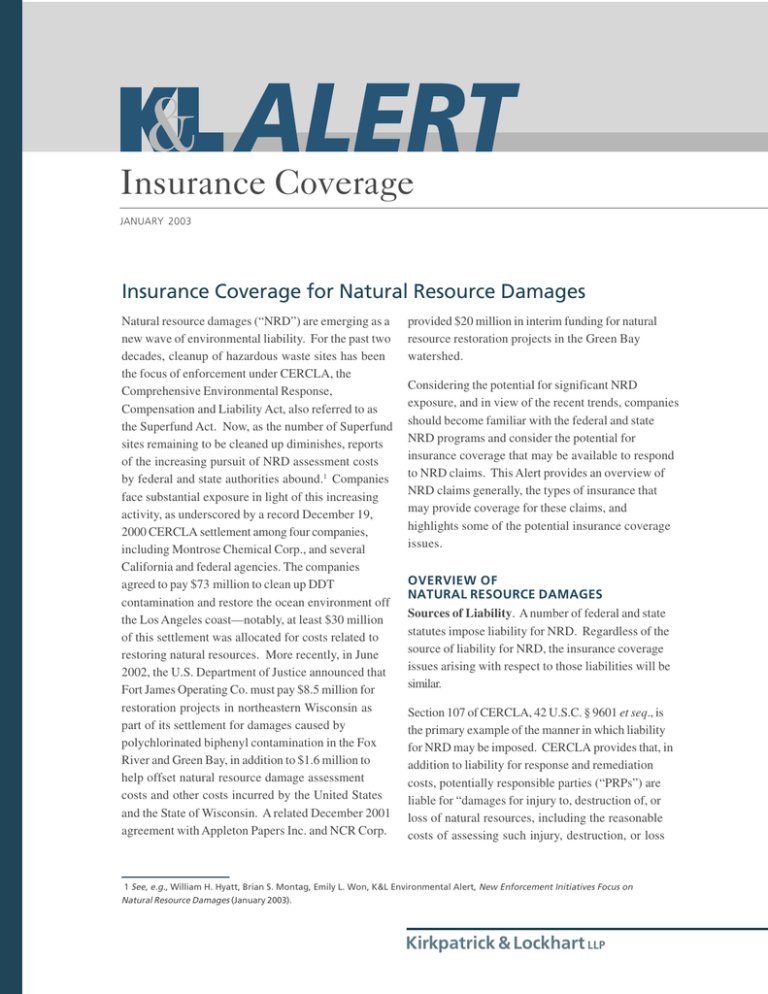
Insurance Coverage JANUARY 2003 Insurance Coverage for Natural Resource Damages Natural resource damages (“NRD”) are emerging as a new wave of environmental liability. For the past two decades, cleanup of hazardous waste sites has been the focus of enforcement under CERCLA, the Comprehensive Environmental Response, Compensation and Liability Act, also referred to as the Superfund Act. Now, as the number of Superfund sites remaining to be cleaned up diminishes, reports of the increasing pursuit of NRD assessment costs by federal and state authorities abound.1 Companies face substantial exposure in light of this increasing activity, as underscored by a record December 19, 2000 CERCLA settlement among four companies, including Montrose Chemical Corp., and several California and federal agencies. The companies agreed to pay $73 million to clean up DDT contamination and restore the ocean environment off the Los Angeles coast—notably, at least $30 million of this settlement was allocated for costs related to restoring natural resources. More recently, in June 2002, the U.S. Department of Justice announced that Fort James Operating Co. must pay $8.5 million for restoration projects in northeastern Wisconsin as part of its settlement for damages caused by polychlorinated biphenyl contamination in the Fox River and Green Bay, in addition to $1.6 million to help offset natural resource damage assessment costs and other costs incurred by the United States and the State of Wisconsin. A related December 2001 agreement with Appleton Papers Inc. and NCR Corp. provided $20 million in interim funding for natural resource restoration projects in the Green Bay watershed. Considering the potential for significant NRD exposure, and in view of the recent trends, companies should become familiar with the federal and state NRD programs and consider the potential for insurance coverage that may be available to respond to NRD claims. This Alert provides an overview of NRD claims generally, the types of insurance that may provide coverage for these claims, and highlights some of the potential insurance coverage issues. OVERVIEW OF NATURAL RESOURCE DAMAGES Sources of Liability. A number of federal and state statutes impose liability for NRD. Regardless of the source of liability for NRD, the insurance coverage issues arising with respect to those liabilities will be similar. Section 107 of CERCLA, 42 U.S.C. § 9601 et seq., is the primary example of the manner in which liability for NRD may be imposed. CERCLA provides that, in addition to liability for response and remediation costs, potentially responsible parties (“PRPs”) are liable for “damages for injury to, destruction of, or loss of natural resources, including the reasonable costs of assessing such injury, destruction, or loss 1 See, e.g., William H. Hyatt, Brian S. Montag, Emily L. Won, K&L Environmental Alert, New Enforcement Initiatives Focus on Natural Resource Damages (January 2003). Kirkpatrick & Lockhart LLP resulting from [a hazardous substance] release.” 42 U.S.C. § 9607(a)(4)(C). Natural resource damages are broadly defined under CERCLA as the following: [L]and, fish, wildlife, biota, air, water, ground water, drinking water supplies, and other such resources belonging to, managed by, held in trust by, appertaining to, or otherwise controlled by the United States ... any State or local government, any foreign government, any Indian tribe, or, if such resources are subject to a trust restriction on alienation, any member of an Indian tribe. 42 U.S.C. § 9601(16). Right of Action. CERCLA restricts the recovery for NRD to the federal government, state government, or Indian tribes. CERCLA authorizes the federal or state governments to act as trustee, or to appoint a trustee, to assess NRD. The trustee may bring a cause of action to recover for injury to natural resources. Monies recovered by the trustee may be used only to “restore, replace, or acquire the equivalent of such resources.” 42 U.S.C. § 9607(f). Valuation. NRD under Section 107 may be awarded to reflect any difference between the value of the affected resource before it was contaminated and its value after the cleanup of the property, plus the lost use value and the costs of assessment. Notably, while all compensatory sums recovered are used to “restore, replace or acquire equivalent natural resources,” CERCLA explicitly allows for compensation in excess of actual damages as well, stating that “the measure of … damages shall not be limited by the sums which can be used to restore or replace such resources.” 42 U.S.C. § 9607(f). Regardless of how the damages ultimately are measured, the breadth of the statutory language demonstrates that the amount of the potential liability may be substantial. OVERVIEW OF INSURANCE AND POTENTIAL COVERAGE ISSUES All-risk property insurance policies and environmental impairment liability policies may be available to respond to NRD claims. However, this 2 Alert focuses on comprehensive general liability (“CGL”) insurance, which has been the principal vehicle for commercial liability insurance protection for over fifty years. CGL policies were first sold in 1940 and cover policyholders for legal liability to third parties for both bodily injury and property damage. These policies also obligate insurers to defend policyholders against claims and to pay any resulting judgments or liability settlements. The standard-form CGL policies sold from 1940 to 1966 covered a policyholder’s liability caused by “accidents.” In 1966, the insurance industry rewrote the standard-form CGL policy. The standard-form CGL policy sold from 1966 until 1985 obligates the insurer to “pay on behalf of the insured all sums which the insured shall become legally obligated to pay as damages because of bodily injury or property damage … caused by an occurrence” and to “defend any suit against the insured seeking damages on account of such bodily injury or property damage ….” The standard-form policy defines “occurrence” as “an accident, including continuous and repeated exposure to conditions which results, during the policy period, in bodily injury or property damage.” The insurance coverage issues that may arise under CGL policies in connection with NRD claims closely mirror those arising with respect to other environmental claims. Some of these issues include the following: Trigger of Coverage. In insurance coverage parlance, the trigger of coverage determines which policies are “triggered” and therefore available to respond and provide coverage in connection with claims. Whether a particular policy has been “triggered” depends on whether the damage took place within the policy period. The “continuous trigger” of coverage typically affords the greatest protection to policyholders. Under the continuous trigger theory, the damage is deemed to occur continuously from the moment of exposure until the final manifestation of injury or damage. In environmental cases, property damage will often be a continuing process spanning several insurance policy periods and involving multiple policies. KIRKPATRICK & LOCKHART LLP INSURANCE COVERAGE ALERT Scope of Coverage. While a continuous trigger generally is considered the most favorable to the policyholder, this trigger raises issues regarding the “scope of coverage,” which refers to the extent of each triggered policy’s obligation to indemnify and/or defend the policyholder (i.e., whether the insurers’ obligations are joint and several, or pro rata). Many courts hold that the “all sums” or similar language in the standard CGL insuring agreement means any triggered policy must cover all of the policyholder’s liabilities arising from the continuous injury or damage, regardless of whether some of the injury or damage occurred outside of the policy period. This is consistent with the policy language, which contains no language limiting the insurer’s obligation to only a portion of damages attributable to injury or damage occurring during the policy period, and with the insurance industry’s historical understanding of its standard CGL insuring agreement. The effect of the “all sums” language is to hold insurers jointly and severally liable to the policyholder for the full amount of the policyholder’s liabilities. The policyholder is entitled to select which triggered policy period it wishes to call upon to address the liability. state insurance commissions in the early 1970s that the exclusion did not cut back on coverage, but instead merely clarified the meaning of “occurrence.” See, e.g., Morton Int’l, Inc. v. General Acc. Ins. Co., 629 A.2d 831 (N.J. 1993). In addition, the phrase “sudden and accidental” in the exception to the exclusion was an insurance industry term of art and did not mean “quick” or “abrupt.” Accordingly, many courts have rejected insurers’ arguments that the exclusion eliminates coverage for most pollution damage. Expected or Intended Defense. As noted above, the definition of “occurrence” allows recovery where injury or damage was “neither expected nor intended from the standpoint of the insured.” Many insurers claim that there is no coverage where the policyholder intends to do the causative act—as opposed to the injury or damage resulting from that act. Many courts have rejected this argument, holding the policy applicable unless the policyholder subjectively intends the resulting injury. “Legally Obligated to Pay as Damages.” Insurers have argued that response costs recoverable under environmental statutes are not “damages” and Pollution Exclusion. Prior to 1971, CGL policies therefore are not covered under the CGL policy. always provided coverage for pollution-related claims. Indeed, the insurance industry’s own representatives While a number of courts have agreed with this position, a majority of courts have ruled to the admitted that their CGL policies prior to 1971 provided contrary, finding that response costs are “damages” this coverage. The “pollution exclusion” was added as and are covered under the CGL policy. Notably, a mandatory endorsement to some of the standardeven courts holding that response costs are not form CGL insurance policies in 1970 and became part “damages” have distinguished actions for NRD. See of the standard-form CGL policy in 1973. That City of Edgerton v. General Cas. Co. of Wisconsin, exclusion provides that the policy does not apply to: 517 N.W.2d 463, 478 (Wis. 1994) (“Response costs … bodily injury or property damage arising out of reflect a congressional intent to differentiate between the discharge, dispersal, release or escape of cleanup or response costs under 42 U.S.C. sec. smoke, vapors, soot, fumes, acids, alkalis, toxic 9607(a)(4)(A) and damages for injury, destruction, or chemicals, liquids or gases, waste materials or the loss of natural resources under 42 U.S.C. sec. other irritants, contaminants or pollutants into 9607(a)(4)(C).”), reconsideration dismissed, 527 or upon the land, the atmosphere or any water N.W.2d 305 (Wis. 1995); Continental Ins. Co. v. course or body of water, but this exclusion does Northeastern Pharmaceutical & Chemical Co., 842 not apply if such discharge, dispersal, release F.2d 977, 986-87 (8th Cir.), cert. denied, 488 U.S. 821 (1988) (distinguishing between actions under or escape is sudden and accidental. CERCLA for cleanup costs and actions under In rejecting insurers’ attempts to avoid coverage CERCLA for NRD and holding that coverage existed based on this exclusion, several courts have been only for the latter). Accordingly, NRD should be persuaded by the fact that the insurers represented to JANUARY 2003 Kirkpatrick & Lockhart LLP CONCLUSION As the interest of administrative agencies in the statutory provisions that allow imposition of liability for NRD increases, the number of companies facing such liability will also increase. Those companies are all likely to have valuable insurance assets that may fund such liabilities. The possibility for insurance coverage is significant and should be explored by any company exposed to these liabilities. recoverable even in jurisdictions where case law precludes policyholders from recovering environmental cleanup costs from insurers. Duty to Defend. As noted above, the standard-form CGL obligates the insurer to defend against “any suit . . . seeking damages on account of such bodily injury or property damage . . .” (emphasis added). Insurers have argued that the CGL insuring agreement requires them to defend only “suits,” and that PRP letters do not constitute “suits.” Some courts agree with this position, reasoning that the term “suit,” although undefined, refers to formal legal proceedings, such as civil litigation or formal administrative adjudications. Other courts, however, conclude that the term “suit” encompasses any effort by a claimant to impose liability on a policyholder that is ultimately enforceable by a court. Generally, these courts focus on the adversarial and coercive nature of PRP letters, and the adverse consequences that may befall a policyholder who does not promptly and adequately defend against the allegations in those letters. THOMAS J. SMITH tsmith@kl.com 412.355.6758 ROBERTA D. ANDERSON randerson@kl.com 412.355.6222 The Insurance Coverage practice group at Kirkpatrick & Lockhart Nicholson Graham LLP offers an international policyholder-oriented practice on behalf of Fortune 500 and numerous other policyholder clients. Its lawyers have authored Policyholder’s Guide to the Law of Insurance Coverage and edited the Journal of Insurance Coverage. For further information, please consult our website at www.klng.com. Notice. Insurance policies typically impose an obligation on policyholders to provide notice “as soon as practicable” to their carriers when an occurrence arises. Some jurisdictions (e.g., New York) read this provision harshly. Others (e.g., Pennsylvania) provide that a carrier, in order to escape the risk, must establish not only untimely notice but also prejudice from untimely notice. FOR ADDITIONAL INFORMATION about these issues, please consult any of Kirkpatrick & Lockhart’s office contacts listed below: Boston Dallas Harrisburg Los Angeles Miami Newark New York Pittsburgh San Francisco Washington Settlement Considerations. Because NRD claims may lag substantially behind pollution cleanup claims, policyholders that settle with their insurers for cleanup costs also should factor in the potential liability for NRD before releasing the insurers from further liability. John M. Edwards Robert Everett Wolin Raymond P. Pepe David P. Schack Daniel A. Casey Anthony P. La Rocco Peter J. Kalis Peter J. Kalis Edward P. Sangster Matthew L. Jacobs 617.261.3123 214.939.4909 717.231.5988 310.552.5061 305.539.3324 973.848.4014 212.536.4828 412.355.6562 415.249.1028 202.778.9393 jedwards@kl.com rwolin@kl.com rpepe@kl.com dschack@kl.com dcasey@kl.com alarocco@kl.com pkalis@kl.com pkalis@kl.com esangster@kl.com mjacobs@kl.com ® Kirkpatrick & Lockhart LLP Challenge us. ® www.kl.com BOSTON ■ DALLAS ■ HARRISBURG ■ LOS ANGELES ■ MIAMI ■ NEWARK ■ NEW YORK ■ PITTSBURGH ■ SAN FRANCISCO ■ WASHINGTON ......................................................................................................................................................... This publication/newsletter is for informational purposes and does not contain or convey legal advice. The information herein should not be used or relied upon in regard to any particular facts or circumstances without first consulting a lawyer. © 2003 KIRKPATRICK & LOCKHART LLP. ALL RIGHTS RESERVED.

